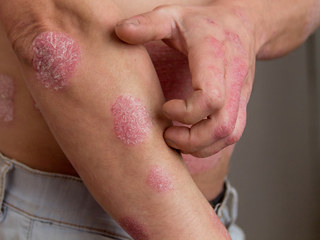Living with psoriasis often feels like anticipating the next flare-up before the last one has healed. One moment your skin is calm, and the next, a new patch emerges on an entirely different part of the body. The typical way it starts is on the scalp, elbows, or knees. And then it tends to spread to the lower back, face, hands, and feet. Though it’s also the reverse in some cases. Sometimes, it appears on nails or even in skin folds. This unpredictability can lead to a sense of helplessness—but the truth is, your everyday habits have a powerful role to play in preventing psoriasis from spreading.
Psoriasis isn’t just about skin; it’s an immune condition that requires gentle, ongoing support. When the immune system gets overactivated, it can trigger a domino effect across the skin. But with the right care and consistency, it’s possible to reduce new patches, strengthen the skin’s resilience, and calm the body’s inflammatory response.
Here are five proven habits that can help prevent psoriasis from spreading—and promote long-term healing.
1. Respond Early and Gently to the First Sign of a Flare-Up
Psoriasis begins beneath the surface. Before visible plaques form, the skin often sends early signals—itchiness, dryness, tingling, or subtle redness. These are not just irritations to ignore; they are your body whispering before it begins to shout.
The reason this matters: psoriasis involves the immune system attacking healthy skin cells, accelerating their production up to 10 times the normal rate. If a psoriasis flare-up is left unaddressed, the inflammation can extend to other areas—a process known as the Koebner phenomenon, where even a small scratch or cut can turn into a new patch.
The habit: Apply a calming anti-inflammatory oil blend at the earliest sign of discomfort. Activated oils—rich in bioactive compounds—can modulate the skin’s immune response, reduce itching, and improve circulation, helping to contain the flare and reduce the risk of spreading.
Tip: Oleum Cottage’s Restorative Oil for psoriasis is formulated with therapeutic oils that target inflammation at the cellular level. When used early, it supports skin regeneration and reduces the intensity of flare-ups. If you want to go even deeper into building a long-term strategy, this psoriasis management plan offers a complete roadmap.
2. Moisturise Like It’s Part of Your Treatment Plan
In psoriasis, dry skin isn’t just uncomfortable—it’s inflammatory. Damaged skin barriers lose water rapidly and send alarm signals to the immune system, further fueling flare-ups.
When the skin is moisturised consistently with therapeutic oils for psoriasis, three key things happen:
-
Barrier lipids are replenished: Oils like virgin coconut, almond, and wheatgerm mimic the skin’s own fats, sealing micro-cracks and reducing transepidermal water loss (TEWL).
-
Inflammatory signals are reduced: Cracked, dry skin releases damage-associated molecular patterns (DAMPs), but well-moisturised skin stays calm.
-
Skin becomes more flexible: Hydrated skin resists micro-tears, reducing the likelihood of new patches forming due to friction or injury.
The habit: Moisturise at least twice daily with Ultra Healing Cream for psoriasis—after bathing and before bed—when the skin is damp and most receptive to oils.
A consistent moisturising psoriasis routine is one of the most effective ways to prevent psoriasis from spreading.
3. Prioritise Deep, Restorative Sleep
Sleep is your skin’s repair cycle. At night, the immune system recalibrates and repairs oxidative damage from the day. In people with psoriasis, poor sleep increases pro-inflammatory cytokines and stress hormones like cortisol—both of which contribute to worsening symptoms.
The habit: Aim for 7–9 hours of quality sleep each night. Create a calm bedtime routine:
-
Avoid screens an hour before sleep
-
Keep the room cool and dark
-
Add a drop of therapeutic grade lavender oil to your pillow or diffuser
During non-REM sleep, skin cell turnover normalises and inflammation subsides—giving your body the pause it needs to reset.
If nighttime itching or flares are affecting your sleep, explore this calming nighttime psoriasis routine designed to help your skin heal while you rest.
4. Eat to Lower Systemic Inflammation
Psoriasis is linked to gut inflammation and immune dysregulation, meaning your food choices can either fuel or fight flare-ups. Certain foods increase immune activity, while others calm it.
Pro-inflammatory foods to limit:
-
Processed sugars
-
Fried foods
-
Red meat, dairy, gluten (depending on individual sensitivity)
Anti-inflammatory foods for psoriasis to include:
-
Omega-3 rich seeds (like flaxseed), walnuts, and fatty fish
-
Berries, turmeric, leafy greens
-
Fermented vegetables and probiotics
These support gut lining health and balance T-reg cells—the immune regulators that prevent self-attack. A nourished gut improves overall psoriasis management and reduces the likelihood of systemic inflammation triggering skin symptoms.
5. Use Gentle Movement to Support Immunity
Exercise helps lower systemic inflammation by decreasing cortisol and increasing IL-10, an anti-inflammatory cytokine. Regular movement also improves circulation, supporting better delivery of nutrients to skin cells and removal of waste.
The habit: Choose low-impact activities that don’t aggravate your skin:
-
Walking
-
Swimming (in salt water or gentle conditions)
-
Yoga and gentle stretching
Just 20 minutes a day can positively impact your mood, immune balance, and skin clarity.
Small Habits, Big Shifts
Psoriasis may be chronic, but it doesn’t have to feel chaotic. When the focus shifts from suppression to support, the body responds with resilience.
Act early, moisturise intentionally, sleep deeply, nourish wisely, and move gently. These habits may seem simple, but over time, they can create a stable foundation for calmer, clearer skin.
At Oleum Cottage, healing begins by listening. With therapeutic plant oils and a science-backed approach, every step is designed to calm inflammation and rebuild from within.


